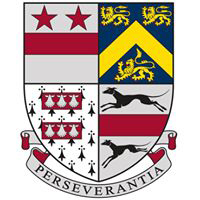
With his family, Ernie Halstead, Master of the Lower School, took groups of boys on holiday, upon this occasion in 1965 (before I became a boarder) to Benodet en Bretagne. Ernie was “a good man,” in the words of one of his former headmasters, quoted in the Silhillian after he died. Mum circled me in ink, in front of Ernie and his wife.
The most miserable year of my life was the year I spent as a boarder at Solihull School, 1966.
I wrote about it in too much detail elsewhere: how dreadfully I missed my little family, how the rich and heartfelt communication we shared at home turned into the dry and disconsolate shrugs of the boarding house, and how my mother’s infectious peals of laughter were replaced by the occasional barks of unhappy bachelors.

In the robe and on a throne-like chair, Bruce McGowan, the progressive Headmaster during my years at the School. Next to him is the flamboyant Guy King-Reynolds, Deputy Head and Master of School House, the boarding house. This dates from the 1969 School photo. I was already long gone.
I cried for uncounted hours all by myself, hiding away in the nooks and crannies of Kineton, the younger boarders’ house, just feeling the emptiness, the void.
So of course when the school finally announced its first ever boarders reunion this summer, I had to go! Really, I wouldn’t have missed it for the world. And it lived up to my expectations, even though these were very unclear: I had no idea why it felt so important to go back.

From the School’s own archives, the first girls in 1973. Ginty Macmillan, whose brother Iain was a friend in my year at Solihull, was one of these girls.
The Old Silhillians I met there, all former boarders, seemed very happy to be visiting. They knew why they were there: on the whole, their school days had been wonderful. In its report on the reunion, the School talked of us “scurrying” around the school, eagerly exploring. Which we did!
We were welcomed by the engaging new Headmaster, David Lloyd, together with his delightful family and a charming collection of his staff and pupils, boys and girls. If memory serves, Bruce McGowan, my Headmaster, whom I liked and admired, included his family very little in school activities with pupils; same for Guy King-Reynolds, his deputy and my Head of the boarding house. They and the other Masters’ wives were notable by their lack of integration: no chance of “Tea and Sympathy.”
And I’m sure that there were no girl pupils at all! The first small group of girls tested the waters at the School in 1973-4.
A jarring note did ring out in the run-up the reunion: two long-term teachers, one of whom I knew, liked and was hoping to see again at the reunion, died on the same day not four weeks before. I left the School over 50 years ago, and had worried that the sheer lapse of time might have depleted the pool of possible attendees. This sad announcement was a regrettable confirmation of the effects of the passing of so much time.
And on the same day? No mention anywhere of a tragic accident or illness or even coincidence. No-one who might know has said what happened, at least not in my hearing. I thought immediately that they must have been involved with each other; how else could they have died simultaneously? Was there was a suicide involved, or some sort of voluntary euthanasia, or both? And this won’t have been deliberate, but the deaths of these two devoted servants of the School right before the first ever boarders reunion must have had an impact on each of us attending.

Boarders reuniting, with a few better halves, including mine There were about three groups like this touring the School with our guides. Not surprisingly, we are all getting on in years.
Similarly, almost none of my peers, the boys in my year or dorm, showed up. Richard Cranston had been one of the only two boarders who had been in my class (most of the boys at the school were day boys, as I had been before starting to board), and I have been looking to reconnect with him for years, to no avail: no show. Simon Billing, who was in the bed next to mine in the School House dorm, told the funniest jokes, and who is now a FaceBook friend in Toronto: no show. Douglas Mackay, whose foot slipping through the roof of Big School, the main assembly hall back then, won us both a good caning at the hands of Harry “Crow” Rickman: no show. Harry Rickman himself sent his regrets by telegram: too poorly to attend. The list goes on.

The wooden honor rolls which dot the School walls include this list of Head Boys. Bart Gribble was Head Boy in 1966: SH identifies him as a member of the School House, the boarding house.
The better side of the reunion was greeting those I knew who did make an appearance. Roger Bart Gribble was there, all the way from his home in Australia, where he emigrated not long after leaving school. Bart was Head Boy of the School in 1966, Head of School House (the boarding house), Captain of the School rugby team, Captain of another School team – The Man, as it were. And I was Bart Gribble’s fag! Living in the San Francisco Bay Area, that sentence rings a rather loud bell, but what it means is less sonorous. I had the privilege of making Bart’s afternoon tea, polishing his shoes and generally performing mundane chores for him, at his entire discretion. He was very nice about it, undemanding, friendly, and with no hint of the kind of bullying that such authority can encourage in an adolescent.
We actually had a decent chat in the Old Silhillians clubhouse toward the end of the reunion, the Head Boy and his fag. I thanked him for being so kind, which prompted him to share one of his proudest accomplishments as Head Boy. He had lobbied for and obtained a prohibition against older boys being authorized to cane or otherwise physically punish their fags. Way to go, Bart!
But you can see how close I lived to institutionally permitted bullying. There was always a darkness for me in the boarding house. Abuse of some kind felt like a constant presence, a constant risk. It wasn’t just homesickness.
During our first engagement at the reunion, the lunchtime welcome in the refectory, Erika (I brought support, just in case!) and I were sitting next to a couple of old boys (the English term for alumni) who told us the central story of their time at the school. The first portion of this story concerned H. B. Hitchens, the school’s headmaster until he died in the summer of 1963. He had committed suicide after “what was rumoured to have been an act of gross indecency in a public toilet.” Of course, no-one is really sure of this. Perhaps Hitchens was akin to Oscar Wilde, perhaps he was a child protecter (as some members of the community thought at the time), perhaps he was a child molester, perhaps he was none of the above: impossible to tell without witnesses.

According to the website of the Birmingham Mail, which hosts this photo, it shows Her Majesty “during her visit to Solihull School in May 1962, The Queen, escorted by Capt. D L Wigglesworth, inspected a guard of honour provided by the combined Cadet force.” Wigglesworth is to Her Majesty’s right, Morle behind and to her left.
But I can’t help but wonder how it must have felt to be gay in the 1950s and ’60s: in such a climate of loneliness and prejudice, was the public toilet the only place “where no-one asks any questions or looks too long in your face, In the darkness on the edge of town?” © Bruce Springsteen, “Darkness on the Edge of Town.”

By the time I saw this portrait of Mr. Hitchens on the wall of School House, where I used to live (now converted to artists’ studios), the two old boys had told us their sad story.
The second part of the lunchtime story, the darker part, has witnesses, the storytellers in the refectory. David L. Wigglesworth, who is referenced in several places in this 1962 school diary was the House Master of School House, the older boys’ boarding house, until the summer of 1964 or thereabouts. That made his departure about a year after his Headmaster’s suicide. (I should add that David had a brother or other relative at the School who was viewed by my story tellers as a very good man.)
While they were senior boys at the school, these men were among those approached by a junior boy who complained that D.L. Wigglesworth was molesting him. They were very concerned; some were house prefects, which they saw as placing a responsibility on their shoulders to act in the best interests of their younger charges. Those boys, now these modest men who do not wish to be named here, are the heroes of this story.
But at first they didn’t see a way to address this abuse successfully. Once it takes hold, it is very difficult to clean up: ask the Catholic Church! Those in authority tend to conspire to avoid damage to their institution’s reputation, and these boys, even though senior boys, were still boys and much lower on the institution’s totem pole than the accused Master. What could they do?
It took them a while, apparently, while the younger boy was becoming increasingly upset, and then they had an idea. They would send a letter to the editor of the Sunday Times denouncing the gross misconduct, which they duly did. Not entirely sure of how or why things transpired after the editor received the letter, because School action on the sole basis of a pupil’s letter to a newspaper seemed unlikely, they were relieved to see Wigglesworth leave his position at the School not long after. The boy who they knew was being molested (and others?) was given that solace at least.
They suspect, although obviously can’t prove, that the School sought to protect itself by simultaneously (1) not publicizing the abuse, and (2) removing the abuser from the abused.
Thirty-five years later, after he died, the Silhillian, the magazine of the old boys club, included an obsequious “Appreciation” of Wigglesworth (page 37). You cannot see the man described here in that obituary, but you can see something shameful hidden beneath the effusive praise which fills it. Wigglesworth’s career continued after leaving Solihull, despite what he had done at the School.
A. H. G. Morle was the housemaster at Kineton, the younger boarders’ house, when I lived there: he apparently was married, but I have no recollection of a wife. It was Morle who wrote the obsequious Appreciation, and described Wigglesworth as having “a highly successful career in a Birmingham State School on leaving Solihull. His (ndlr Wigglesworth’s) final appointment was with Solihull Education Authority in the Inspectorate where he was pre-eminent.”

The School House football (soccer) team, 1969-70. Cranny is bottom right, next to Guy Billing, Simon’s brother. David Felix-Davies, the dorm bully when I was there, who apparently now lives in Florida, is next to his brother and behind Cranny.
Let’s spend a moment to unpack that. First, Solihull School apparently agreed that there would be no prosecution of Wigglesworth, but felt that he had done enough wrong to be obliged to leave prestigious positions with the School. It accordingly allowed its abuser to continue to work in secondary education in the same geographic area. Not only were the lives of the abused boy who spoke up and perhaps peers of his at Solihull School ruined, but Wigglesworth was allowed to move on and ply his trade elsewhere.

An official reunion photographer took this one, with the regrettable consequence that I have no idea who I was chatting with at that moment! This was in the refectory before we sat down to eat.
Second, the Solihull Education Authority oversees the schools in its domain. I don’t know in what ways then or now, but Wigglesworth was potentially responsible for responding to complaints from pupils or parents who felt that their school was not protecting children from predators. Talk about the fox in the henhouse! If his predilections continued, Wigglesworth could have been in the position of enabling others to partake of the sins in question.
That was the most awful aspect of the Catholic Church’s response to child abuse by priests: they simply moved the priest to another parish so that no one would be any the wiser, ignoring that another captive audience of children was available in the destination parish.
In short, there was something very dark hidden in the recesses of School House. In his servile Appreciation of the disgraced Wigglesworth, Morle commented that: “David’s personal standards were of the highest . . .”, Really? Did Morle honestly not know what his close colleague had been up to? To my mind, rather than admit and confront the evil once hidden within the School, its representative dissimulated it under a cloak of lies, hoping that time and the lies would reverse what had happened.
And what of the abused boy(s)? Was he (were they?) able to overcome the scars left behind? Was he (were they) able to reverse the effects of the abuse?
“Well, everybody’s got a secret, Sonny, Something that they just can’t face, Some folks spend their whole lives trying to keep it, They carry it with them every step that they take . . . “. © Bruce Springsteen, “Darkness on the Edge of Town.”
By holding a boarders’ reunion, finally, the School must have known that this darker part of the boarding house’s history might again be shared. More power to those who decided to go ahead and face that risk. You can’t just hide the darkness, shoving it under the rug. The School itself is a lot sunnier place than in was in the ’60s, and has been becoming brighter since the first girls arrived in 1973. Cleaning out the closet can’t do any harm.
But that’s where I lived in 1966, in the darkness on the edge of town.




